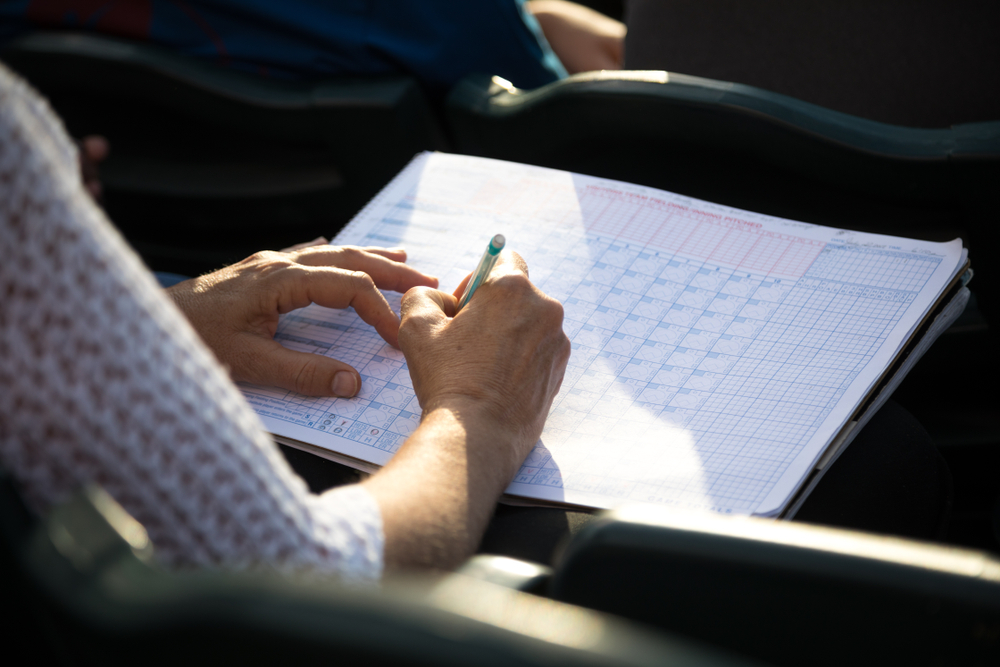Keeping score in baseball is a practical skill that enhances your understanding of the game. Whether you’re a youth baseball coach aiming to grasp the finer details or a parent cheering from the stands at Ballparks of America, this guide breaks down the essentials of scorekeeping.
Let’s dive into the straightforward approach to documenting each play and making sense of the game on paper.
Getting Started With the Basics of a Scorecard
A baseball scorecard is essentially a grid that tracks each player’s turn at bat and the progression of each inning.
Columns represent player positions, while rows correspond to innings. Familiarizing yourself with this grid is the initial step toward becoming an effective scorekeeper.
Player Positions and Numbers
Youth baseball players wear jerseys with numbers on their backs, which you can write down on the scorecard. Each playing position in the field also has a number, which will correspond to each player.
On your scorecard, jot down the player’s number and the relevant position. This simple mapping ensures you can quickly identify who’s at bat, on base, or playing in the field.
- Pitcher
- Catcher
- First baseman
- Second baseman
- Third baseman
- Shortstop
- Left fielder
- Center fielder
- Right fielder
Scoring Symbols
Think of scoring symbols as simple notations for plays. You need to understand the shorthand used to represent various plays to keep score effectively.
Common symbols like “K” for a strikeout, “BB” for a walk, and “1B,” “2B,” “3B,” and “HR” for singles, doubles, triples, and home runs respectively, help you record the game’s progress concisely.
Each grid on an expanded scorecard has an outline of the baseball diamond in miniature. Getting a single would mean drawing a line from home to first base. Getting a homerun is indicated by filling in the entire diamond with a pencil mark.
Documenting the Game Flow
Your scorecard essentially becomes a running account of hits and runs. For each player’s at-bat, record whether it results in a hit, walk, or an out.
Using the scoring symbols, you can capture the dynamics of the game, documenting advancements on the bases and celebrating each run scored.
Outs and Innings
Keep track of the number of outs in each inning. A straightforward “1-2-3” notation signifies three quick outs, marking the end of an inning. Documenting innings helps maintain a chronological record of the game, providing a clear timeline of key moments and transitions.
Another thing to think about is the defensive plays. A fly-out to the left fielder would be F7. A ground out to 2B throwing to 1B would be GO 4-3. A double play would be DP 4-6-3 for the 2B throwing to second with the shortstop covering and then relaying the throw to first base.
Pitch Counts
Understanding pitch counts is essential for player development and safety in youth baseball. Create a dedicated section on your scorecard to track the pitches each pitcher throws.
Related Post: Building the Next Generation of Aces: Youth Baseball Pitching Guide for Coaches
This supports coaching decisions and instills an awareness of pitch count management in young players.
Defensive Plays
A complete scorecard doesn’t only focus on offensive plays. It also acknowledges stellar defensive efforts.
Related Post: 4 Essential Infield Defense Drills to Keep Your Baseball Team Engaged
Use your scorecard to note exceptional catches, throws, and defensive maneuvers. This enriches your documentation and encourages young players to take pride in their defensive contributions.
Tips for Parents
For parents watching from the stands at Ballparks of America, keeping score is a practical way to engage with the game. Share the responsibility of scorekeeping with other parents, creating a collaborative effort that builds a sense of community. Encourage your child to participate in keeping score, fostering a deeper understanding of the game’s nuances.
As the game concludes, your scorecard transforms into a keepsake of memories. Add personal touches, like noting outstanding plays or memorable moments. Over time, these scorecards become souvenirs that capture the journey of a baseball season.
Train and Play at Ballparks of America
Keeping a baseball scorecard is a practical skill that adds depth to the experience of watching youth baseball at Ballparks of America. Players and parents can create a straightforward narrative beyond the final score by understanding the basics, tracking hits and runs, documenting outs and innings, and embracing the language of scoring symbols.
We live and breathe baseball at Ballparks of America. Sign up for one of our tournaments today and take advantage of our outstanding facilities and dedicated staff. For questions, contact us at Ballparks of America or (417) 464-6333.





